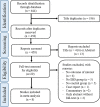The Relationship Between Rosacea and Inflammatory Bowel Disease: A Systematic Review and Meta-analysis
- PMID: 37338720
- PMCID: PMC10307732
- DOI: 10.1007/s13555-023-00964-6
The Relationship Between Rosacea and Inflammatory Bowel Disease: A Systematic Review and Meta-analysis
Abstract
Introduction: Rosacea and inflammatory bowel disease (IBD) are chronic inflammatory disorders of the skin and the gut, which are interfaces between the environment and the human body. Although growing evidence has implicated a possible link between rosacea and IBD, it remains unclear whether IBD increases the risk of rosacea and vice versa. Therefore, we investigated the association between rosacea and IBD in this study.
Methods: We performed a systematic review and meta-analysis according to the Preferred Reporting Items for Systematic Review and Meta-analysis (PRISMA) guidelines.
Results: Eight eligible studies were included in this meta-analysis. Overall, the prevalence of rosacea was higher in the IBD group than in the control group, with a pooled odds ratio (OR) of 1.86 (95% confidence interval [CI](1), 1.52-2.26). Both the Crohn's disease and the ulcerative colitis groups had higher prevalences of rosacea than the control group, with ORs of 1.74 (95% CI 1.34-2.28) and 2.00 (95% CI 1.63-2.45), respectively. Compared with those in the control group, the risks of IBD, Crohn's disease, and ulcerative colitis were significantly higher in the rosacea group, with incidence rate ratios of 1.37 (95% CI 1.22-1.53), 1.60 (95% CI 1.33-1.92), and 1.26 (95% CI 1.09-1.45), respectively.
Conclusion: Our meta-analysis suggests that IBD is bidirectionally associated with rosacea. Future interdisciplinary studies are needed to better understand the mechanism of interaction between rosacea and IBD .
Keywords: Colitis; Crohn’s disease; Inflammatory bowel disease; Meta-analysis; Rosacea; Systematic review; Ulcerative.
© 2023. The Author(s).
Conflict of interest statement
Yu Kyung Jun, Da-Ae Yu, Yoo Min Han, Soo Ran Lee, Seong-Joon Koh, and Hyunsun Park have nothing to disclose.
Figures



Similar articles
-
The relationship between inflammatory bowel disease and rosacea over the lifespan: A meta-analysis.Clin Res Hepatol Gastroenterol. 2019 Aug;43(4):497-502. doi: 10.1016/j.clinre.2018.09.009. Epub 2018 Oct 30. Clin Res Hepatol Gastroenterol. 2019. PMID: 30389397
-
Association between autism spectrum disorder and inflammatory bowel disease: A systematic review and meta-analysis.Autism Res. 2022 Feb;15(2):340-352. doi: 10.1002/aur.2656. Epub 2021 Dec 23. Autism Res. 2022. PMID: 34939353
-
Rosacea in Patients with Ulcerative Colitis and Crohn's Disease: A Population-based Case-control Study.Inflamm Bowel Dis. 2016 Mar;22(3):680-7. doi: 10.1097/MIB.0000000000000644. Inflamm Bowel Dis. 2016. PMID: 26717319
-
Global Prevalence and Bidirectional Association Between Psoriasis and Inflammatory Bowel Disease-A Systematic Review and Meta-analysis.J Crohns Colitis. 2020 Mar 13;14(3):351-360. doi: 10.1093/ecco-jcc/jjz152. J Crohns Colitis. 2020. PMID: 31504363
-
Association of rosacea with inflammatory bowel disease: A MOOSE-compliant meta-analysis.Medicine (Baltimore). 2019 Oct;98(41):e16448. doi: 10.1097/MD.0000000000016448. Medicine (Baltimore). 2019. PMID: 31593075 Free PMC article.
Cited by
-
Atopic dermatitis and food allergy: More than sensitization.Mucosal Immunol. 2024 Oct;17(5):1128-1140. doi: 10.1016/j.mucimm.2024.06.005. Epub 2024 Jun 19. Mucosal Immunol. 2024. PMID: 38906220 Review.
-
Causal relationship and potential pathogenic mechanisms between rosacea with pharyngeal and laryngeal cancer.Braz J Otorhinolaryngol. 2025 Jul-Aug;91(4):101636. doi: 10.1016/j.bjorl.2025.101636. Epub 2025 Apr 25. Braz J Otorhinolaryngol. 2025. PMID: 40286597 Free PMC article.
-
A systematic review and network meta-analysis of the association between periodontitis and inflammatory bowel diseases.BMC Oral Health. 2025 Mar 31;25(1):463. doi: 10.1186/s12903-025-05830-9. BMC Oral Health. 2025. PMID: 40165211 Free PMC article.
-
Detecting potential causal relationship between inflammatory bowel disease and rosacea using bi-directional Mendelian randomization.Sci Rep. 2023 Sep 9;13(1):14910. doi: 10.1038/s41598-023-42073-6. Sci Rep. 2023. PMID: 37689807 Free PMC article.
References
Publication types
LinkOut - more resources
Full Text Sources

